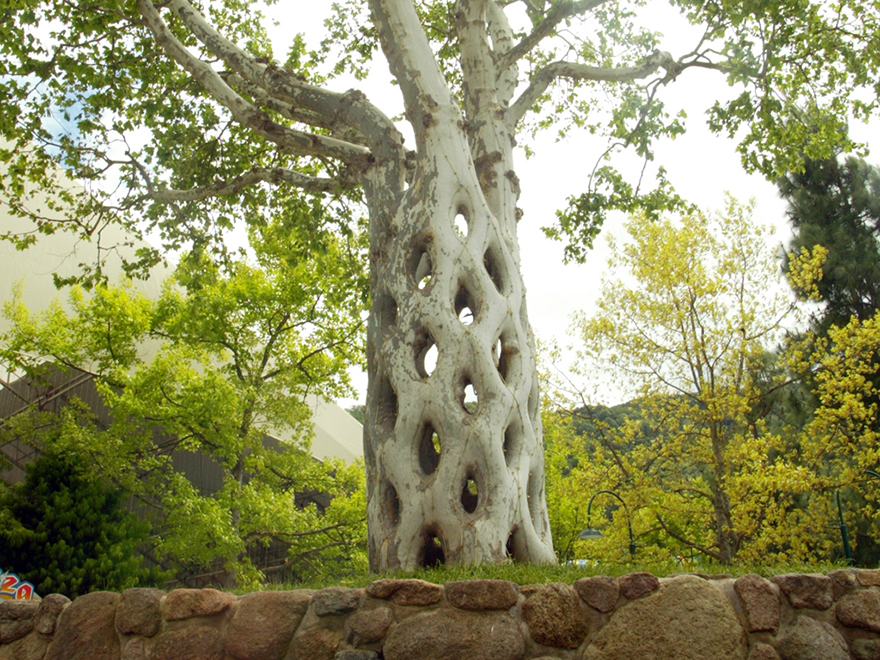
Sometimes two tree branches will grow in such a way that they begin to touch. As the wind blows the branches and they rub together, the bark at the point of contact is gradually worn away, exposing the cambium. As the branches continue to grow, becoming thick enough to minimize their movement in the wind, bark can then re-grow around the point of contact, fusing the two branches together. This process is called inosculation, and in the 1920s a Swedish immigrant named Axel Erlandson observed it happening on his California farm.
Erlandson figured he'd give inosculation a go, and soon he was tinkering with sycamores to create geometric, conjoined shapes, symbols like hearts and lightning bolts, and weaving multiple trees in a circle to create baskets. Twenty years later, his property was covered with them.








In 1945 Erlandson's wife and daughter, fresh off a vacation to Santa Cruz, observed that there was a lot of tourist traffic there along the coast, as opposed to their sleepy farm in Hilmar some 100 miles inland. Together they hatched the crazy idea that if they uprooted and moved Erlandson's arboreal creations to the coast, they could sell tickets to tourists to view the oddities.
Amazingly, they pulled it off. Erlandson dug the trees up, carefully pruned the roots and wrapped them in peat moss and burlap, and somehow trucked the things over to a 3.5-acre plot of land he purchased in Scotts Valley, some six miles outside of Santa Cruz. I was not able to find a record of the precise number of trees he transported, but it was enough to open the tourist attraction he called "The Tree Circus" in 1947.

For publicity's sake, Erlandson did the 1940s version of sending a Tweet to Digg: He snail-mailed two photographs of his trees to the syndicated Ripley's Believe It or Not! newspaper feature. The resultant foot traffic, and a Life Magazine feature in the 1950s on the now 70 trees Erlandson had going, was enough to keep the place running for 17 years.
Erlandson sold the attraction in 1963 for $12,000, which is about $93,000 in 2014 dollars, and died a year later.
Following his death, the trees changed hands a number of times, with increasingly neglectful owners. By the '70s only 40 trees were left, and they narrowly avoided being bulldozed, saved only by California architect Mark Primack's campaign to save them. But while Primack saved them from the woodchipper, their number continued to dwindle, with a loss of 11 more trees.
By the '80s Primack had succeeded in inspiring a tree fan to rescue them. In 1985 Michael Bonfante ponied up to have the 29 remaining trees dug up and transported 50 miles away, to what is now the Gilroy Gardens Theme Park outside of Gilroy, California.
Today just 25 of the trees are left, sprinkled throughout an amusement park featuring rides, playgrounds, gardens, a petting zoo and a water park. Says Gilroy Gardens' website of the Circus Trees:
These trees represent one of the most visible demonstrations of the love of nature by man--first to create and nourish, then to maintain, and finally to preserve and cherish these stunning creatures. With a lot of love and a bit of luck, Axel Erlandson's Circus Trees will continue to awe children as well as adults who can appreciate the time and talent involved in creating this tribute to nature.

No comments:
Post a Comment